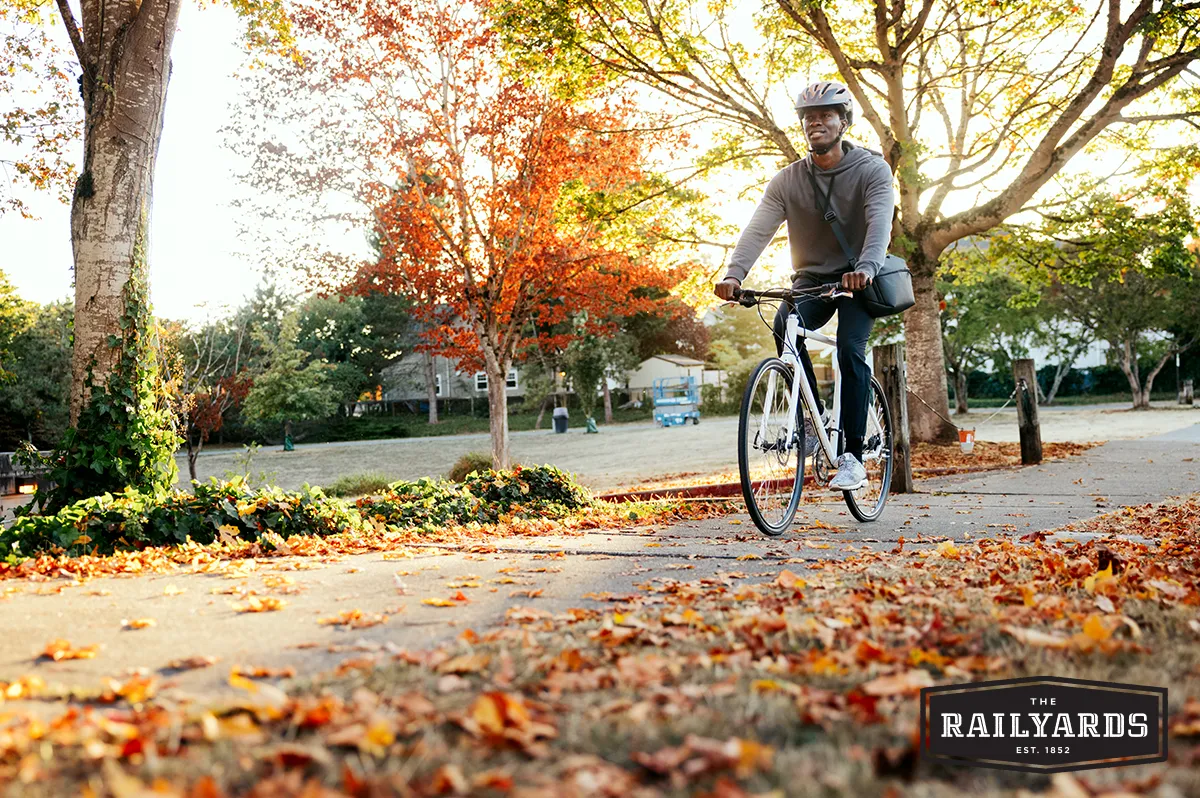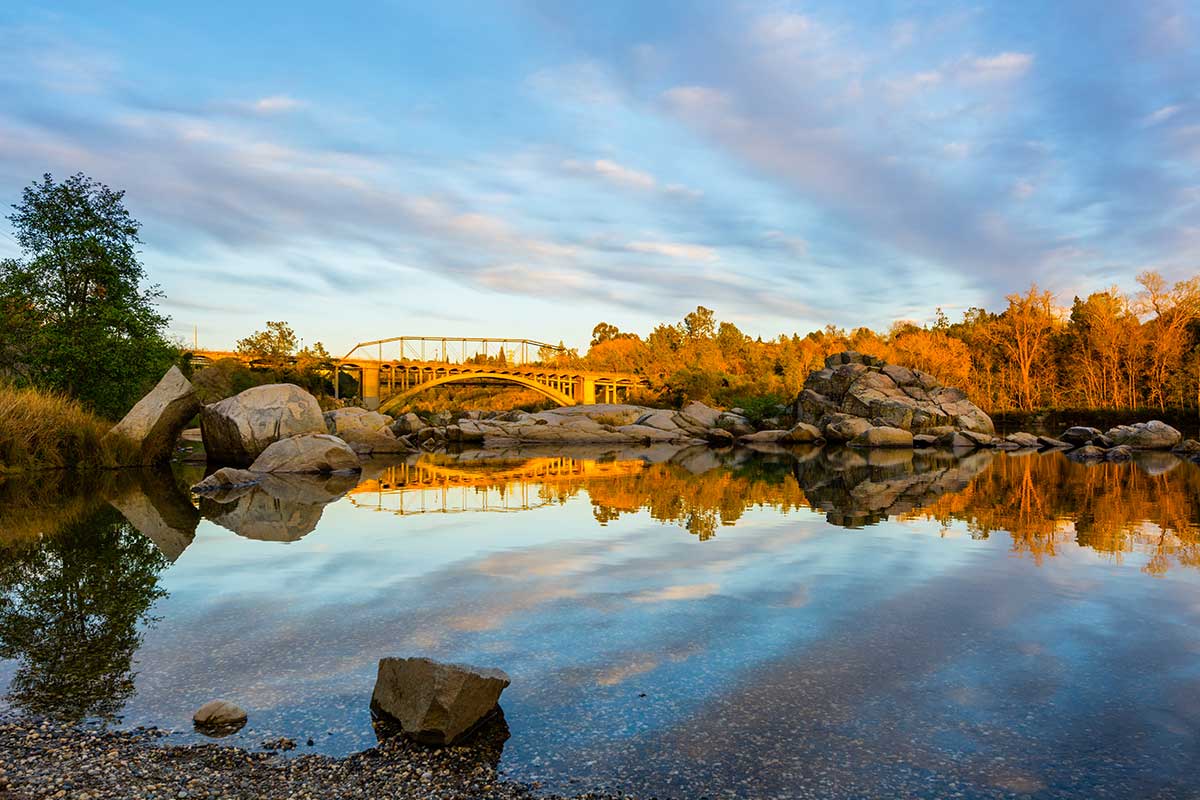
January 2, 2025 / Author: the Railyards
When riding this winter, there are some tips you should keep in mind to ensure you’re keeping safe and having fun.
Winter is coming, and if you plan on cycling in Sacramento this season, staying prepared, informed, and safe is important. Sacramento winters are downright mild compared to others, but it’s still the wettest, coldest, and darkest time of year to ride your bike.
Check out some of these winter bike riding tips below so you can continue to cycle — warmly and safely — this winter.
Be Ready for Rain
November through February is the rainy season when more than half of the year’s precipitation falls in Sacramento. However, it usually only rains measurably for about ten days per month.
Tips for safely cycling in the rain:
- Lower tire pressure: Reduce tire pressure to increase traction.
- Add mudguards: Mudguards help keep your rear dry and warm. You can choose mudguards that attach to your frame or saddle.
- Use bike lights: Use bike lights when visibility is poor, such as in heavy rain, at night, or during dawn or dusk.
- Avoid standing water: Puddles can be deeper than they appear and can cause hydroplaning.
- Use chain lube: Apply a thicker chain lube designed for wet conditions to protect your chain from rust.
- Dry your bike: After riding, wipe down your bike and make sure all steel parts are dry.
- Use plastic bags: Use plastic bags to keep your clothes dry or to cover your bike seat.
- Wear the right gear: Wear a waterproof jacket, overshoes, gloves, and a cycling cap.
Get the Right Bike
Mountain bikes, hybrids, and single-speed bikes are often the preferred types of bikes for winter riding.
Regardless of your bike type, there are adjustments you can make for safer and easier winter riding.
Swapping out your warm-weather tires for studded or wider tires can help increase traction on wet or icy roads. Deflating tires slightly in the winter allows more of the tire’s surface area to be in contact with the road.
Changing a flat tire on a bike is difficult enough, but it can be even more challenging in the cold. Consider getting puncture-resistant tires or tubes. Tubeless tires contain no inner tubes, which makes getting flats less likely. If you have tubed tires, you can install a tire liner between the tube and wheel rim to make them sturdier.
If you ride with clipless pedals or toe straps during the summer, you may want to consider swapping them out for platform pedals in the winter, which work well with winter footwear. A platform pedal may also make it easier to put a foot down in case of a slippery situation.
Light the Way (and Yourself)
The sun goes down early and rises late in the mornings, so you must have the proper lighting conditions set up on your bike and person to keep you safe. Reflector jackets and lights are also a must so you can be seen from anywhere. It’s also good to note that batteries drain more quickly in the cold, so fully charge your batteries before each ride and also carry any extra batteries you may need during your ride.
Bike Lights
You should have two lights for the front, and two for the back of your bike to provide backup in case one fails.
Front lights: The brightest light should go on your handlebar, while the other should go on your arm or helmet so you can orient it independently from your handlebar light.
Rear lights: Place a bright flashing light on the back of your bike and the other on your helmet, pack, or clothing. This makes it so the two lights' motion varies slightly, making it easier for drivers (and other riders) to spot you more easily.
How bright are we talking?
It is safest to assume that there will be no street lights or very few while you’re riding. A minimum brightness for the front handlebar light would be about 500 lumens. You should aim for at least 100 lumens for the back of your bike. Any secondary lights can be less bright as long as they’re visible.
Reflective Clothing
Most clothing made for biking (unless specifically for off-roading) will have some sort of reflective trim on it. However, the more reflective, the better. If you don’t want to give up your favorite rain jacket, wear a reflective vest or bands over it.
A good rule of thumb is to have at least one reflective element visible from any direction. You can also add reflectors or reflective tape to your clothing or bags to make those more visible.
Keep Tires Winter Ready
Inflate your tires to the low end of their pressure range. You can usually find the acceptable pressures on the sidewalls of the tires themselves. Riding on tires that are filled to the low range puts more tire surface on the road, increasing your traction. A tire that feels slightly soft will also absorb bumps more efficiently, which can help if you run into potholes or gravelly patches.
Check your tire pressure before EVERY ride. This is typically the most overlooked aspect of maintenance in cycling. Since you might be pumping them to the low end of their pressure limits and because tires lose pressure slowly over time (especially in the cold), it’s good to check them before every ride.
Prepare What You Wear
Sacramento winter temperatures typically range from 40° - 60°F, but it’s not uncommon for freezing temperatures to occur in December and January.
A good rule of thumb is to dress as if it’s 10° warmer when cycling than if you were walking around. Layers are helpful, so you can adjust based on your ride difficulty and personal preferences. Waterproof outer layers can help keep you dry on rainy winter days.
Most cyclists opt for a wicking base layer underneath the rest of their clothing. But you should at least wear some tights, a long-sleeve, and a waterproof jacket and pants. None of this needs to be bike-specific clothing, either. Just make sure that you’re comfortable, visible, and dry.
Headwear
Cycling caps or ‘skull caps' are great for keeping your head and ears warm. You can also pair them with a face mask if you’re going out in frigid weather or a helmet that covers more of your head. Goggles or glasses can also be an excellent addition to protect your eyes.
Bike Gloves
Get some fully waterproof gripped cycling gloves that can keep your hands warm and also ensure that you can safely operate your brakes and handlebars in cold or wet weather.
Bike Footwear
Cycling shoes tend to have a tighter fit, making pedaling easier. Some cyclists opt for slightly larger shoes in the winter to allow for thicker socks. Wind and waterproof additions also exist to keep you warmer. When you get off your bike, ensure the shoes have good traction so you don’t slip.
More Winter Cycling Safety Tips
Maintaining your bike before and after your rides can make it even safer during winter riding sessions.
Clean Your Bike
Keep your bike clean after winter rides. Even with fenders, rain, dirt, and grime can build up fast, especially in winter. Wiping down your chains, drivetrain, brakes, and other parts right after you finish riding — or at least once a week — will prolong your bike’s efficiency.
Every few weeks, you might opt for doing a deeper clean and lube your chain. Buy a “wet” lube that is made for wet/dirty climates. Dry chains do not perform well in cold conditions.
Store It Safely
Rain and cold temperatures can hurt your bike, so it’s best to store it indoors if possible. If that’s not possible, storing it under carports, building eaves, or anywhere where it’s sheltered. You may consider a bike cover if you can’t store it out of the weather.
If you drive an electric bike, remember that batteries drain quickly in the cold so make sure to store the battery inside or charge it up before you ride. Some battery packs also come with covers you can wrap them up overnight.
Take it Easy
Even if you’re an experienced rider, cycling in winter hits differently, so ease your way into it. Overextending yourself poses risks to your health, can be a morale-killer, and make rides harder to get through. If you have a long journey ahead of you, consider taking public transportation for part of the way to preserve your energy and warmth. Consider alternating riding days during the winter. The Sacramento Valley Station has public transportation options that can get you — and your bike — all over the region on cold, blustery, or freezing days.
Cycling in Sacramento during the winter can be just as satisfying as warmer months, if you’ve prepared for the darker, colder, and wetter rides. Take advantage of the relatively mild winters in the Sacramento region and get your bike winter-ready.
Hit the trails: discover these ten swoon-worthy Sacramento bike trails to love.











